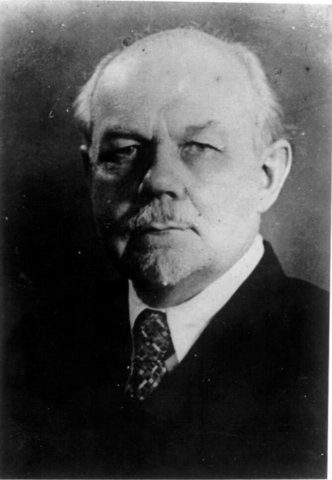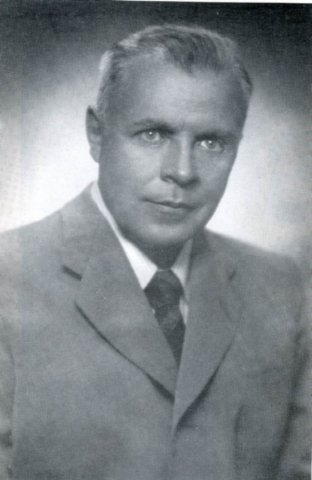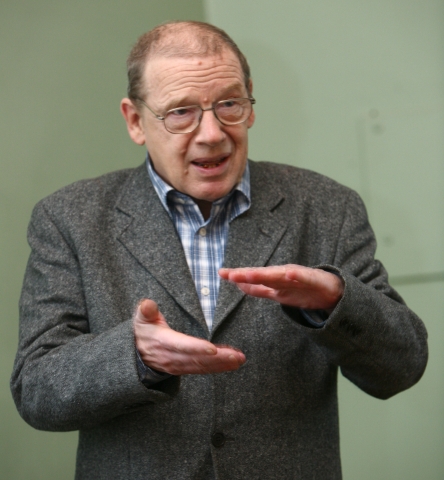|
The Magnetic Laboratory was established at Moscow University in 1919 at the height of the Civil War on the initiative of Professor Vladimir Konstantinovich Arkadiev (since 1929 - Corresponding member of the USSR Academy of Sciences)
 |
Vladimir Konstantinovich Arkadiev
1884 — 1953 |
Vladimir Konstantinovich entered Moscow University in 1904. Already in the first year, he actively worked for Professor Umov. He was engaged in determining the speed of propagation of magnetic waves along iron rods. After passing a physical workshop with Professor Sokolov in 1906, he received an offer from P. N. Lebedev to work in his laboratory. At the end of 1907, Arkadiev discovered the limit of the speed of magnetization of iron, for which he received the prize of the Society of Lovers of Natural Science (1908). In 1909 Arkadiev made a trip to Europe, and in 1913 he participated in the congress on the kinetic theory of matter in Gottingen. In the same year, he visited Vienna at the Congress of German naturalists, where he met A. Einstein, W. H. Keezom, A. Sommerfeld, H. Busch and many other famous physicists.
During the First World War, Arkadiev switched to defense research in the field of chemical defense, for which he organized a Physical and Chemical Laboratory. In 1918 Arkadiev returned to Moscow University and organized the Moscow Magnetic Laboratory in 1919 (in 1931 it was transformed into the J. Maxwell Laboratory of Electromagnetism). Since 1932, V. K. Arkadiev has been a professor at Moscow University. In 1939, he became head of the Department of Theoretical Electrical Engineering, which he led until the end of his days.Arkadiev's main works are devoted to the theory of magnetism. The phenomenon of selective absorption of alternating field energy in ferromagnets, called ferromagnetic resonance (1913), was discovered and a theory of this phenomenon was developed. The concept of magnetic viscosity is introduced. A generalized law of electromagnetic induction is proposed. He laid the foundations of magnetic spectroscopy. In 1943, V. K. Arkadiev, based on the theory of the skin effect, pointed out the possibility of creating a magnetic flux compressor to produce super-strong magnetic fields. He created a school of physicists (N. S. Akulov, A. A. Glagoleva-Arkadieva, V. A. Karchagin, K. F. Teodorchik, E. I. Kondorsky, K. M. Polivanov, F. F. Panasenkov, I. B. Kirko, A.V. Peryshkin, R. V. Telesnin).
 |
Nikolai Sergeevich Akulov
1900 — 1976 |
The magnetic laboratory, created by corresponding member of the Academy of Sciences V. K. Arkadiev in 1919, existed for a long time due to the enthusiasm of the director and his students, receiving almost no support, except for the premises provided by Moscow University. Since 1923, it began to receive financial assistance from the VEI vsnh and since 1926, it was directly funded by glavnauka as the laboratory's work received international fame and recognition. The main areas of work of the laboratory were: the development of the theory of the electromagnetic field (the idea of the complex nature of magnetic permeability was introduced, methods for calculating losses on induction currents were proposed, the laws of reflection of electromagnetic waves from ferromagnetic surfaces were obtained), general and magnetic spectroscopy (the dependence of magnetic permeability on the frequency of electromagnetic waves); on magnetostatics, magnetorelaxis and magnetostriction (demagnetizing factors for cylindrical bodies are calculated and methods for calculating the parameters of electromagnets are proposed, expressions are obtained that determine the rate of magnetization and demagnetization of iron and nickel wires, the relationship of magnetostriction with hysteresis parameters is investigated); on electric vibrations (a method and device for generating ultrashort waves are proposed, methods for measuring the parameters of electromagnetic waves are developed).
Special mention should be made of the seminars organized in the magnetic laboratory. The results obtained by the laboratory's staff and postgraduates were presented and scientific publications of foreign scientists were discussed. V. K. Arkadiev's speech at the seminar was an indicator of the speaker's high qualification. Many foreigners on their own initiative sought to visit the Magnetic Laboratory.
In July 1930, the University was reorganized -the faculties of the University were transformed into departments, while the mechanical , Physical and astronomical-mathematical departments were organized on the basis of the Faculty of Physics and Mechanics. And in December 1931, the first department of magnetism in the USSR appeared at the Physics department. Nikolai Sergeevich Akulov is appointed professor of this department, its head on the recommendation of V. K. Arkadiev. Together with him at the department since its foundation were E. I. Kondorsky, N. L. Bryukhatov, K. P. Belov, D. I. Volkov, M. V. Dekhtyar, D. R. Vedenev, M. A. Grabowski, and others. When the faculty system was restored at the university in April 1933, the Department of Magnetism became part of the Faculty of Physics
Only in the first year of existence of the Department of Magnetism N. S. Akulov and his students laid the foundations of the general theory of the magnetization curve of mono-and polycrystals, the theory of galvanomagnetic and galvanoelastic effects, the theory of magnetostriction. In subsequent years, the Department has made a number of fundamental works on ferromagnetism: laid the foundations of the General theory of magnetization curve of single crystals and polycrystals produced research in ferromagnetic anisotropy, created the theory of the galvanomagnetic and galvanoplastic effects, etc.
In 1939, the future successor of N. S. Akulov as head of the Department of Magnetism, E. I. Kondorsky, brilliantly defended his doctoral dissertation. By this time, the Department of Magnetism of Moscow State University and the Magnet laboratory at the Institute of Physics of Moscow State University became a center for research on magnetism and a school for training highly qualified personnel.
During the Great Patriotic War, the department, along with the entire university, was evacuated first to Ashgabat, and then to Sverdlovsk. After 1943, the university returned to Moscow. After the war, the number of students began to increase again and by 1947 reached the pre-war level. Many employees returned from the army, and the staff of the department under the leadership of Nikolai Sergeevich continued to enthusiastically engage in science. Was defended a dissertation for future famous magnetologists of the USSR.
In 1953, the situation in the country became tense. Death and. Stalin and the subsequent arrest and execution of L. Beria in December 1953 brought the country into a state of expectation of change. Akulov's opponents tried to take advantage of this. The Department of Magnetism, as well as the Faculty of Physics, received frequent commissions. In the midst of moving the university to a new building, a resolution of the Central Committee of the CPSU dated 5 August 1954 was issued. As a result, the dean of the Faculty of Physics, Prof. A. A. Sokolov and Deputy Dean for Science, Associate Professor F. A. Korolev, and Professors N. S. Akulov and V. F. Nozdrev were removed from their posts. Akulov and Nozdrev were dismissed from the university. It was written about Nikolai Sergeyevich that he "interfered with the organization of business relations between university scientists and scientists of the USSR Academy of Sciences"
Nikolai Sergeyevich was forced to leave his native Moscow University and the department, which he created and turned into the most famous school of magnetologists. (You can read more about N. S.Akulov in the book Akulov Nikolai Sergeev.)
From 1954 to 1987, the Department of Magnetism was headed by Professor Evgeny Ivanovich Kondorsky . At Moscow University, he gave a course of lectures on "magnetic phenomena and Physics", "Magnetism and Zone Theory", "Solid state and Physics", "Quantum theory of solid state". He was Awarded the Order of the Red Banner of Labor in 1951. Winner of the State Prize of the USSR in 1984. (For the cycle of works "Magnetism and electronic structure of rare-earth and uranium compounds" 1959-1982, the obtained results laid the physical foundations for the purposeful search for new high-performance materials for radio electronics and computer technology).
E. I. Kondorsky is the founder of the theory of micromagnetism. He first formulated the criterion of absolute single-domain, discovered new quasi-single-domain states of microparticles. He developed a theory of coercive force and magnetization curves. He developed the theory of the anomalous Hall effect and created the theory of the anomalous Nernst-Ettingshausen effect. He established the connection of these effects with the topology of Fermi surfaces. He proposed the idea of latent antiferromagnetism to solve the invar problem, including the explanation of magnetic anisotropy and antiferromagnetism of chromium. He initiated the development of work on the magnetism of biological micro-objects, cells, cell fragments and model analogues of biological cell membranes.
Prof. E. I. Kondorsky participated in the development of means of protecting naval ships from magnetic mine-torpedo weapons of the enemy. With his participation, a series of electromagnetic devices was developed for the aviation industry and the production of armor-piercing shells.
His doctoral dissertation was defended on the topic "Magnetization process and hysteresis of ferromagnets in the field of small and medium inductions".
E. I. Kondorsky is the author of about 400 scientific papers, five monographs and textbooks on magnetism.
Under his leadership, more than 16 doctoral and about 40 PhD theses were defended. During the years of his leadership, the School of magneto-optics was established and took a leading position in the world, headed by Professor George S. Krinchik.
From 1987 to 2013, the department was headed by a professor Anatoly Vladimirovich Vedyaev.
 |
Ведяев Анатолий Владимирович
род. 1940 |
At Moscow University, he teaches courses for undergraduate and graduate magnetologists: "Physics of Magnetic Phenomena", "Selected Chapters of the theory of magnetism", "Electronic structure and properties of transition metal Alloys".
Research interests: physics of magnetic phenomena, physics of the condensed state of matter. Anatoly Vladimirovich is one of the founders of the foundations of the theory of disordered systems. His work served as the basis for the theory of the electronic structure and kinetic properties of disordered transition and rare earth metal alloys. In the theory of the superconducting state, he investigated the mechanisms of superconducting pairing in highly correlated systems. In recent years, his research interests have focused on the theory of magnetic nano-and heterostructures with unique magnetic properties, such as giant magnetoresistance and giant tunnel magnetoresistance. Under his leadership, the Department of Magnetism conducts theoretical and experimental studies of the static and dynamic properties of these systems. Within the framework of his proposed theory, new quantum effects were predicted, which later received experimental confirmation. His approach allowed us to propose a quantum device that can be a prototype of the so - called "qubit" - an element for creating a quantum computer.
Under the direct supervision of Professor A.V. Vedyaev, seventeen PhD theses and five doctorof science theses were completed. Anatoly Vladimirovich is the founder of the school that studies the transport properties of magnetic and composite materials.
A.V. Vedyaev published more than 150 scientific papers, including monographs: "Phase transitions and electronic structure of alloys "(coauthors O. A. Kotelnikova, M. Yu. Nikolaev and A.V. Stefanovich, 1986) and "Transport phenomena in disordered ferromagnetic alloys" (coauthors A. B. Granovsky, O. A. Kotelnikova, 1992).
Since 2013, the department is headed by Professor Nikolai Sergeyevich Perov.
From the first years of its existence, the Department of magnetism has actively cooperated with foreign magnetologists. Employees and graduates of the department worked in Germany, Czechoslovakia, Hungary, and Cuba. Currently, the Department of Magnetism is actively engaged in scientific research within the framework of cooperation agreements with universities in France, Japan, Korea, Germany, Italy, and Spain. Employees of the department participated in the implementation of various international grants: INTAS, ISTC, etc.
Employees, graduate students and students of the Department of Magnetism have repeatedly participated in the organization of the All-Russian school-seminar "New magnetic materials of Microelectronics", the department has already held seven times Moscow International Symposium on Magnetism, which is attended by up to a thousand magnetologists from all over the world.
At the moment magnetism division is a consolidated collective which moves towards the glorious future in the magnetism science.
|